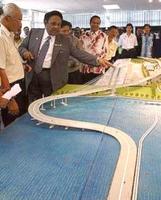A Crooked Bridge is a NO-NO

Malaysia must not build a “crooked” bridge for it will be a permanent monument to the absurd lengths that some leaders will go to complete a flawed decision.
Who will pay for such a bad decision?
Ordinary citizens will ultimately pay for all bad government decisions for the government derives income from the taxes paid by the citizens.
Some claim that a crooked bridge will be a thing of unusual beauty, as overseas visitors will be drawn by the unusual design.
The most likely comment from a Singaporean tour leader would be, “Okay folks, this is where we leave Singapore and enter Malaysia. As you can see from this bridge, everything in Malaysia is done in a crooked fashion. If you get into trouble and don’t know what to do, just let me know and I will settle the problem for you.”
Pricing of such large projects should always be of major concern for it will affect the company’s viability and the ability of the users to pay the toll necessary to recover the costs.
According to the NST report, the bridge will be about 1.4km long costing RM640m with Singapore sharing half the cost. The CIQ and other related developments will bring the whole project cost to RM1.1b. As this was an integrated project with little information provided, only the bridge cost has been mentioned.
Can one assume that the project developer will be provided land near the complex to develop shopping complexes and other commercial property?
Otherwise, how is the project going to be viable?
Even now, there are reports that the Second Link is not recovering project costs as traffic flow has been below expectations.
There have also been no details of the tolls to be charged for the proposed bridge. One would expect that the toll would be at least double the existing rates. Have any studies been carried out on how business in Johor Baru will be affected by the tolls with the new bridge?
The Second Link project also has some reports that have conflicting details. One report mentions RM2.47b while another quotes RM1.6b. Now which report can we believe? RM870m is quite a significant sum. Why that is enough to pay for the proposed bridge!
To put matters into proper perspective, here is some information that may provide useful benchmarks on how bridge projects are managed elsewhere.
1. Delhi Noida Bridge – this is a project funded by the World Bank costing US$100m for a 8lane 10.3km project, 552m main bridge, 3 minor bridges completed 2001
2. Audit Report of a UK bridge
3. Comparative bridge costings between 2003 and 2004
4. Complaints about a USA bridge project:
5. Even with Freedom of Information acts, problems in the UK
6. Typical questions when a major project is planned:
If we aspire to be a developed country by 2020, Malaysian leaders should seriously consider these issues properly rather than launch a billion ringgit project on a whim and a fancy.
Meanwhile, traffic on the Causeway would be more orderly if there is just one traffic policeman booking errant drivers who obstruct traffic or jump queues. If this is done consistently and if all the immigration booths are manned fully, the Causeway jams may become history.
Will anyone care to bet that jams will still occur even after we spend that RM1.1b on this project?
photo: malaysiakini

1 Comments:
I think DrM was also quoted that the bridge is just to let water flow in the straits.
I agree that not many sea-going vessels can sail under the crooked bridge.
If you live in JB you will know that any large vessel will find it difficult to avoid ending in the Floating City just to the left of the photo.
Post a Comment
<< Home